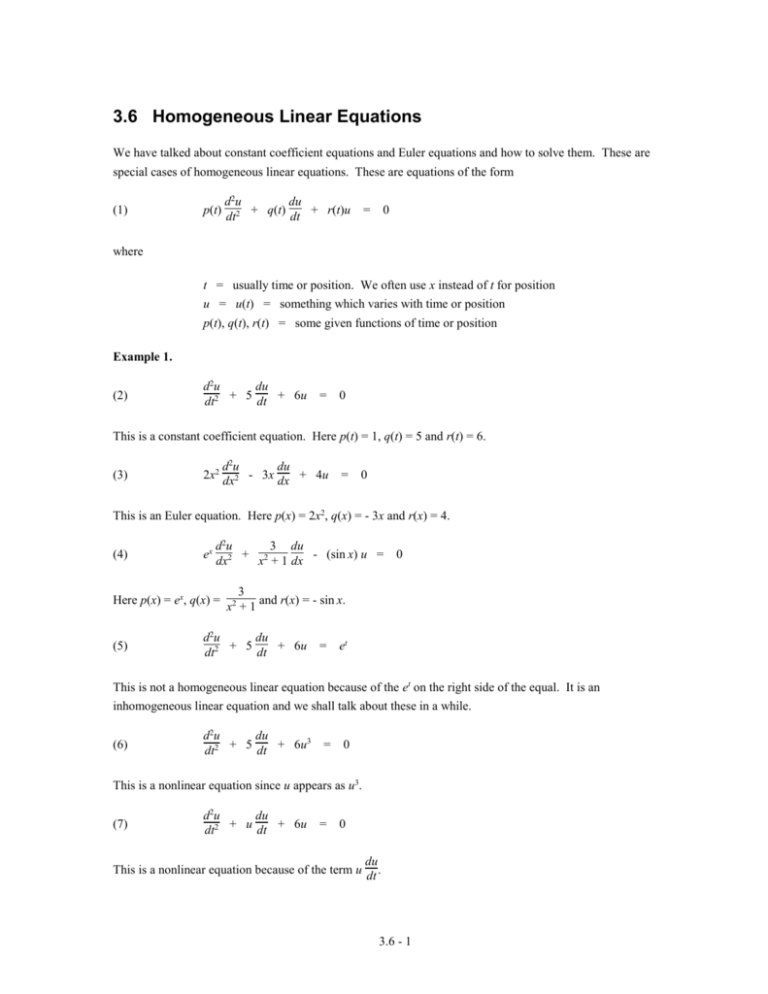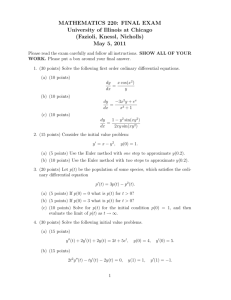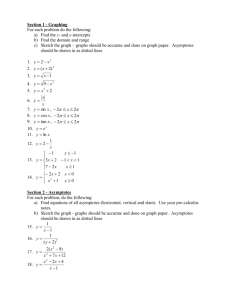3.6 Homogeneous Linear Equations
advertisement

3.6 Homogeneous Linear Equations We have talked about constant coefficient equations and Euler equations and how to solve them. These are special cases of homogeneous linear equations. These are equations of the form (1) p(t) d2u du + q(t) + r(t)u dt2 dt = 0 where t = usually time or position. We often use x instead of t for position u = u(t) = something which varies with time or position p(t), q(t), r(t) = some given functions of time or position Example 1. (2) d2u du + 5 + 6u dt2 dt = 0 This is a constant coefficient equation. Here p(t) = 1, q(t) = 5 and r(t) = 6. (3) 2x2 d2u du - 3x + 4u dx2 dx = 0 This is an Euler equation. Here p(x) = 2x2, q(x) = - 3x and r(x) = 4. (4) ex d2u 3 du + 2 - (sin x) u = dx2 x + 1 dx Here p(x) = ex, q(x) = (5) 0 3 and r(x) = - sin x. x2 + 1 d2u du + 5 + 6u dt2 dt = et This is not a homogeneous linear equation because of the et on the right side of the equal. It is an inhomogeneous linear equation and we shall talk about these in a while. (6) d2u du + 5 + 6u3 dt2 dt = 0 This is a nonlinear equation since u appears as u3. (7) d2u du + u + 6u dt2 dt = 0 This is a nonlinear equation because of the term u du . dt 3.6 - 1 Things Which Are True About Homogeneous Linear Equations 1. In general, it is not possible to express the solution of a homogeneous linear equation (1) in terms of familiar functions or even integrals of familiar functions. There are some important special cases such as constant coefficient equations or Euler equations where one can. Despite the fact that it is not possible to express the solution in terms of familiar functions, one does have the following existence & uniqueness theorem. Existence and Uniqueness Theorem. Suppose in (1) the functions p(t), q(t) and r(t) are continuous on some interval a < t < b and p(t) is not zero for a < t < b. Furthermore, suppose t0 is a point in the interval a < t < b and u0 and v0 are numbers. Then there is a unique solution to (1) which also satisfies the initial du conditions u(t0) = u0 and (t0) = v0. dt 2. The superposition principle that we have used for constant coefficient equations and Euler equations also is valid for general homogenous linear equations of the form (1). If u1(t) and u2(t) are two solutions of (1) then so is C1u1(t) + C2u2(t) for any constants C1 and C2. Furthermore, if the function p(t) is not zero on some interval a < t < b and the two solutions u1(t) and u2(t) are not multiples of each other, then any solution u(t) of (1) on this interval can be written as a superposition u(t) = C1u1(t) + C2u2(t) for some constants C1 and C2. In a situation like this C1u1(t) + C2u2(t) is called the general solution. Example 2. With a little bit of work (see Problem 1 below) one can show that u1(x) = cos x and u2(x) = x sin x are two solutions of Bessel's equation of order 1/2. x (8) x2 d2u du 1 + x + (x2 - ) u dx2 dx 4 Therefore u(x) = = 0 C1 cos x + C2 sin x is a solution for any constants C1 and C2. x du 2 = 0 and dx 2 = 1. Example 3. Find the solution u(x) of Bessel's equation of order ½ that satisfies u C1 cos x + C2 sin x . Putting in x = /2, one has 0 = u = 2 x C1 cos(/2) + C2 sin(/2) C2 C1 cos x = . Therefore C2 = 0 and u(x) = . Taking the derivative one has /2 /2 x du du (x) = - (C1/2) x-3/2cos x – C1 x-1/2 sin x. Putting in x = /2, one has 1 = = - (C1/2) (/2)-3/2cos(/2) – dx dx 2 (/2)1/2 cos x C1 (/2)-1/2 sin(/2) = – C1 (/2)-1/2. Therefore C1 = - (/2)1/2 and u(x) = . x From Example 2 one has u(x) = Remark. Bessel's equation of order is (9) x2 d2u du + x + (x2 - 2) u dx2 dx = 0 3.6 - 2 3. Usually one can obtain a numerical solution to an initial value problem for a homogeneous linear equation using mathematical software. For example, the NDSolve function in Mathematica does this. See Section 3.11 for examples. 4. If u1(t) and u2(t) are two functions then their Wronskian is the function defined by u1(t) du1(t) dt W(t) = W[u1, u2](t) = u2(t) du1 (t) dt Example 4. In some cases one can express the solution of a linear homogeneous equation (1) in terms of power series. A good example of this is Bessel's equation of order zero. This is the equation. (8) x d2u du + + xu dx2 dx = 0 The solution of this equation is u(x) = C1J0(x) + C2Y0(x) where C1 and C2 are any constants and J0(x) and Y0(x) are the Bessel functions of order zero given by (8) J0(x) = (-1)k x2k (k!)2 22k = 1 - k 2k x2 x4 x6 … + (-1)2 x2k + … 2 2 + 2 4 2 6 + (1!) 2 (2!) 2 (3!) 2 (k!) 2 k=0 x 2 Y0(x) = [ ln + ] J0(x) + 2 2 (9) (-1)k+1 Hk x2k (k!)2 22k k=1 1 1 1 + 1 x4 1 + 1 + 1 x6 (-1)k+1 1 + + … + x2k 2 2 2 3 2 k x 2 x = [ln + ]J0(x) + [ + -…+ + …] (3!)2 26 (k!)2 22k 2 (1!)2 22 (2!)2 24 2 Hk = the kth harmonic number = = Euler's constant = 1 1 1 … 1 + + + + 1 2 3 k lim (Hk - ln k) 0.577 k For more examples of using power series to solve differential equations, see Chapter 6. Problem 1. Show that u1(x) = cos x sin x and u2(x) = are two solutions of Bessel's equation of order 1/2. x x Problem 2. For each of the following differential equations determine if it is linear or nonlinear. If it is linear classify it as being homogeneous or nonhomogeneous with constant coefficients or variable coefficients. 1. 6 d2y dy + = xy dx2 dx Answer: Linear, homogeneous with variable coefficients 2. x d2y dy – y = sin x dx2 dx Answer: Nonlinear 3.6 - 3 d2x dx = t + 4x – ln t dt2 dt 3. 3t2 4. d2y + y = tan d 2 Answer: Linear, nonhomogeneous with variable coefficients Answer: Linear, nonhomogeneous with constant coefficients Problem 3. What can you say about existence and uniqueness of the solution to the following initial value problem and the interval on which the solution exists. (1-t) d2x dx + t – 2x = sin t, dt2 dt x(0) = 1, dx (0) = 1. dt Answer. The solution exists and is unique and it exists for - < t < 1. Problem 4. For each of the following pairs of functions y1 and y2, determine if the pair of functions is linearly independent or linearly dependent. Also, compute the Wronskian W[y1, y2](x). 1. y1(x) = x, y2(x) = x2 x x-3 2. y1(x) = e , y2(x) = e 3. y1(x) = sin x, y2(x) = cos(x - /2) Answer: Linearly independent. W = x2 Answer: Linearly dependent. W = 0 Answer: Linearly dependent. W = 0 Problem 5. Verify that the functions y1(t) = et and y2(t) = t2 + 2t + 2 are linearly independent solutions of the d2y dy differential equation t 2 – (t+2) +2y = 0. Then find the general solution of the differential equation. Then dt dt dy find the solution of the differential equation that satisfies the initial conditions y(1) = 0 and (1) = 1. dt Answer. The general solution is y = C1et + C2(t2 + 2t + 2). The solution that satisfies the initial conditions is y = 5et-1 - (t2 + 2t + 2). 3.6 - 4






